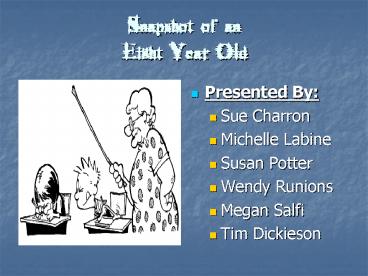Snapshot of an Eight Year Old - PowerPoint PPT Presentation
1 / 20
Title:
Snapshot of an Eight Year Old
Description:
Girls may be faster runners, but boys may be superior in activities requiring ... Stages 1 & 2 up to Age 10. Kohlberg - Continued. Level 2: Conventional Moral ... – PowerPoint PPT presentation
Number of Views:46
Avg rating:3.0/5.0
Title: Snapshot of an Eight Year Old
1
Snapshot of an Eight Year Old
- Presented By
- Sue Charron
- Michelle Labine
- Susan Potter
- Wendy Runions
- Megan Salfi
- Tim Dickieson
2
You Now Have a Grade 3 Class What Should YOU
Expect?
3
Physical Characteristics
- Girls are 9 15 months ahead of boys in terms of
physical growth - Girls may be faster runners, but boys may be
superior in activities requiring strength and
coordination - Controlled movement and development of hand/eye
coordination - Left/Right hand dominance more established
4
Social/Emotional Characteristics
- Students are outgoing, active, and competitive
- Self critical can accept strengths/short
comings - Develop an interest in other people
- Interact more easily with adults but are
beginning to challenge authority - Close friendships with same sex may develop
- Conflicts can be settled verbally
5
Language/Intellectual Characteristics
- Use more complex sentences
- Oral reading becomes more fluent and expressive
- Personal style in writing begin to emerge
- Can focus on more than one perspective
- Can describe a sequence of events
- Real objects still necessary to assist learning
6
And the Theorists Say
7
Piaget...For the Grade 3 Teacher
- Intellectual growth (through social interaction
and discovery learning) - Concrete Operational Stage
- Concrete work/experimentation
- Social Interaction
- Children learn through play
8
vygotskyFor the Grade 3 Teacher
- Cognitive Development through social interaction
and cultural tools - Language is key to cognitive dev.
- Private speech
- Scaffolding
- Zone of proximal development
- Strategies assessment, culturally authentic
tasks, cooperative work
9
GardnerFor the Grade 3 Teacher
- Theory of Multiple Intelligences students
think/learn in different ways - Physical Bodily-Kinesthetic
- Social/Emotional Interpersonal, Intrapersonal
- Language/Intellectual Verbal-Linguistic,
Mathematical-Logical, Musical, Visual-Spatial - How to Use in the Classroom Work Centers for
each intelligence (based on units of study i.e.
Pioneers)
10
EriksonFor the Grade 3 Teacher
- Social/Emotional Development
- Ages 6-12 the Industry vs. Inferiority stage
- Child must learn new skills and incorporate these
skills into their home model - Social Interaction is important
- Child must experience success to allow for a
growing sense of competence - At school Work toward realistic goals and allow
students to show their independence
11
KohlbergFor the Grade 3 Teacher
- Level 1 Preconventional Moral Reasoning
- Stage 1 Punishment-Obedience Orientation
- Stage 2 Personal Reward Orientation
- Stages 1 2 up to Age 10
12
Kohlberg - Continued
- Level 2 Conventional Moral Reasoning
- Stage 3 Good Boy-Nice Girl Orientation
- Stage 4 Law and Order Orientation
- Level 3 Postconventional Moral Reasoning
- Stage 5 Social Contract Orientation
- Stage 6 Universal Ethical Principle Orientation
- To help students move to the next stage
- Expose them to reasoning at a stage above their
own - Give students opportunities for role playing
13
GolemanFor the Grade 3 Teacher
- Emotional Intelligence
- Encompasses 5 characteristics self-awareness,
mood-management, self-motivation, empathy, and
managing relationships - Students learn EI skills through their
interaction with other children and adults - At school programs based on empathy, how to
calm yourself down when you are anxious (i.e.,
red-light, yellow-light, green-light programs)
14
Promoting Student Growth
15
Physical
- Scenario Developing Fine Motor Skills
- Our Observations While some students are
writing smaller (and with less of a grip), there
are others who are still experiencing
difficulties - Initial Growth Demonstrate how to hold onto a
pencil, move away from thicker pencils - Continued Growth Using smaller manipulatives
(i.e. Lego Blocks or Knex), provide notebooks
with smaller lines
16
cognitive
- Scenario Problems in Mathematics
- Our Observations While some students are visual
learners, there are others who still need
concrete manipulatives to understand - Initial Growth Begin each unit with a concrete
exercise (i.e. Frogs and Toads) - Continued Growth Allow students to use
manipulatives and to explore and see if they work
best for them
17
emotional
- Scenario Highly Self Critical
- Our Observations Students in this age group can
become focused on the quality of their work which
can create unnecessary stress - Initial Growth Offer verbal positive
reinforcement and keep track of student success - Continued Growth Move away from the constant
reassurance cycle and encourage students not to
compare marks
18
moral
- Scenario Challenging Authority Figures
- Our Observations Students begin to see how
far they can go before receiving a reprimand - Initial Growth Strategies for students to
correct their own behaviour and developing
classroom rules together - Continued Growth Discussions of bullying and
serious consequences for students who do not take
this seriously, Role Playing
19
Each child is a unique person with an
individual pattern and timing of growth, as well
as individual personality, temperament, learning
style, and experiential and family background.
All children have their own strengths, needs, and
interests for some children, special learning
and developmental needs or abilities are
identified.http//www.naeyc.org/resources/posit
ion_statements/dap3.htm
20
And NowAn Activity- Transformational Geometry

